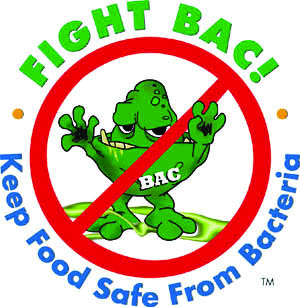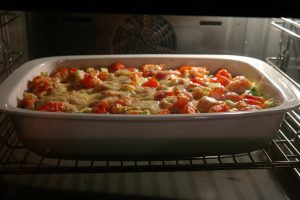Broccoli Salad
- 1 bunch broccoli or 1/2 bunch of broccoli and 1/2 head of cauliflower, washed and cut into pieces
- 2 pieces of bacon, cooked crisp and crumbled
- 1/4 cup onion, chopped
- 1/2 cup raisins
- 1/2 cup low-fat mayonnaise (or plain non-fat yogurt)
- 2 tablespoons cider vinegar
- 2 tablespoons sugar
Directions
- Make dressing of mayonnaise, vinegar, and sugar.
- Combine broccoli, bacon, onion, and raisins.
- Stir in dressing.
- Cover and refrigerate.
Nutrition Information Per Serving
110 Calories, Total Fat 3g, Saturated Fat 1g, Protein 3g, Total Carbohydrate 18g, Dietary Fiber 3g, Sodium 210mg. Excellent source of vitamin C. Good source of vitamin A.
Introducing your baby to solid foods
How do you know your baby is ready for solid foods? He or she will give you cues. In our newest video, let’s take a look for cues that your baby is ready for solid foods.

Pack lunches safely

I enjoy creating and preparing meals for my husband and I. In most cases we have leftovers, which are primarily used for lunch the following day. This not only saves us money, but is usually a healthier option than purchasing food from a restaurant (and many of us can agree that most leftovers taste better the second time around).
However, leftovers that are not packaged safely can be dangerous.
Whether you’re packing lunch for a child, spouse or even yourself, you want to make sure that your leftovers are packed safely. Germs that grow on food can make lots more germs in a little over two hours. Without smart packing, some of the foods and snacks may end up making you sick. Follow these safety tips to avoid foodborne illnesses when transporting food for lunch.
- Keep foods clean – Keep everything clean when packing the lunch.That includes food, food preparation surfaces, hands and utensils. Use hot, soapy water.
- Keep foods out of danger – Bacteria grow and multiply rapidly in the danger zone between 40 ºF and 140ºF. Keep lunches out of direct sunlight and away from radiators or other heat sources. Some foods that don’t require refrigeration and are great to include in a bag lunch are fruits, vegetables, hard cheese, unopened canned meat or fish, chips, bread, crackers, peanut butter,jelly, mustard and pickles.
- Keep cold foods cold – The best way to keep food cold is with an insulated box. When packing lunches, include either freezer gel packs or cold food items such as small frozen juice packs. Nestle perishable meat, poultry or egg sandwiches between these cold items. Sandwiches can also be made ahead of time and kept refrigerated or frozen before placing in the lunch bag. Freezer gel packs will hold cold food until lunchtime, but generally will not work for all-day storage. Any perishable leftovers after lunch should be discarded and not brought home. Of course, if there’s a refrigerator at work, store perishable items there upon arrival. Leftover perishables that have been kept refrigerated should be safe to take home. Brown paper bags or plastic lunch bags can also be used to store foods if you are not carrying perishable foods, but they do not work as well for cold foods. The bag tends to become soggy or leak as cold foods thaw, and the bags do not retain the cold as well as an insulated lunch box. If a freezer gel pack is being used in the paper bag, it will cause additional moisture as it melts. Wrap the freezer pack in plastic or foil and use an extra paper bag to create a double layer to help solve the problem.
- Keep hot foods hot – Foods like soup, chili and stew need to stay hot. Use an insulated bottle stored in an insulated lunch box. Fill the bottle with boiling water, let stand for a few minutes, empty and then put in the piping hot food. Keep the insulated bottle closed until lunch to keep the foods hot.
For more information and tips on how you can safely package your lunch, click the following link: http://www.clemson.edu/extension/hgic/food/pdf/hgic3600.pdf
Stephanie
Pizza Meat Loaf
Looking for recipes that will help you prepare balanced meals for your family on a tight budget? Check out the cookbook. It’s a great guide created specifically to help those of us on a budget plan and prepare healthy, thrifty meals for our families. Whether for breakfast, lunch or dinner, this cookbook is a winner! To get started, try this simple recipe!

Pizza Meat Loaf
Servings: 4 servings about 1/4 loaf each
Ingredients:
- 1 lb. Ground turkey
- ¾ cup Spaghetti sauce
- ¼ cup Mozzarella cheese, part-skim
- ½ cup Green peppers, chopped
- ¼ cup Onion, minced
PREPARATION TIME: 15 MINUTES
CONVENTIONAL COOKING TIME: 20 MINUTES
MICROWAVE COOKING TIME: 8 MINUTES
- Lightly grease 9-inch pie plate with vegetable oil. Pat turkey into pie plate.
CONVENTIONAL METHOD
- Place turkey in 350˚ F oven; bake until turkey no longer remains pink, about 17 to 20 minutes.
MICROWAVE METHOD
- Cover turkey with waxed paper.
- Cook on high; rotate plate 1/4 turn after 3 minutes.
- Cook until turkey no longer remains pink, about 5 more minutes. Drain.
TO COMPLETE COOKING
- Top baked turkey with spaghetti sauce, cheese, and vegetables.
- Return turkey to either the conventional oven or the microwave oven and heat until cheese is melted, about 1 to 2 minutes.
PER SERVING:
Calories 255 Total fat 14 g Saturated fat 4 g Cholesterol 88 mg Sodium 376 mg
Source: http://www.marketmakeovers.org/sites/default/files/FoodPlansRecipeBook.pdf
Fruity Frozen Treats

Fruity Frozen Treats
Makes 8 ‐1 freeze servings
Ingredients:
- 1 8‐ounce container nonfat lemon yogurt
- 2 cups cubed, seedless watermelon
- 1 pint fresh strawberries, tops removed
- 1 medium banana, peeled and sliced
Supplies: 12 muffin‐tin with paper baking cups
Preparation:
- Place yogurt and fruit in a blender. Cover tightly.
- Blend until smooth. Pour into muffin tin.
- Freeze until frozen solid, at least 2‐3 hours.
To serve, remove from freezer and let sit about 10 minutes. Peel paper cup off each treat and eat.
Preparation time: 10 minutes, plus 3 hours freezing time
Source: USDA
